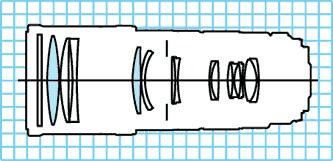Perhaps your first use of a lens was that of a magnifying glass or a microscope, binoculars, or maybe even a rangefinder, the last three of these dealing with focal length. The magnifying glass does not, because there's only one element, one piece of ground glass shaped convex on both sides to create the illusion of magnification. The clarity of that illusion remains fixed at a certain distance from the object, say an ant soon to meets its demise from concentrated rays of the sun, you little masochist. Move the lens back and forth and watch the concentration of light intensify, or focus. When that lens has reached the proper physical distance between it and the optic nerve of your eye where you have clarity, you've created focal length.
In the camera obscura it looks something like this:
This is better illustrated here.
Since that's inconvenient to move the element back and forth, and because of the need to focus along a variable focal plane, while magnifying what's seen, a second element comes in handy. By changing the distance between these two ground glass elements, the focal plane can be moved on its Z axis pulling objects into focus along that axis.
In photography there are two types of combinations of this ground glass, primes and variables, or fixed and zoom lenses.
Prime Lenses (Fixed)
The most basic and essential lens in any bag is the 50mm prime. There was a time when 35mm bodies actually shipped with 50mm primes, but the short zoom has since taken its place in most packages. The f/1.8 50mm is the least expensive, around $90 for the Canon shown below. This is Canon cheapest and lightest lens in their, made entirely of plastic except for the glass.

If that's not fast enough, Canon makes an f/1.4 version of the same, but we're no loner talking cheap or light: $400 and no plastic.

If you're the type that has to have the blown V8 Hemi, you won't settle for anything less than Canon's f/1.2 50mm. This takes lots of plastic with a MSRP of $1000.

DSLR's convert 50mm to 80mm, a perfect focal length for portraiture.
Second in the prime pecking order is the 35mm, a semi wide angle that doesn't look wide. Excellent for landscapes, automobiles and motorcycles, it provides a wide field just before distortion.


The holy trinity of primes rounds out with a fast telephoto, a 300mm f/4. The Canon shown below has image stabilization. Don't knock it until you've tried it... in low light situations. In the field we call this AST (ass-saving technology).


Variable Lenses (Zoom)
In photography everything is a compromise, especially if you're on a college-student budget. Where primes are fast, they're cumbersome and clumsy when it comes to quick lens changes. Variable lenses are composite glass designed to give the shooter a range of focal length while sacrificing speed, in most cases up to four stops.
Short zooms comprise a wide to medium (24mm-70mm) focal length and have replaced the 50mm prime as standard equipment. Long zooms (70mm-300mm) get you close, but on standard glass you're stuck with nothing less than 5.6. Of course, faster is better and much more money.
Canon's EF 24mm-70mm 2.8 will put you back $1,350.00, whereas a slower 28mm-90mm will seems like a deal for a hundred bucks. You get what you pay for.


